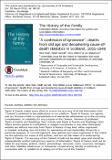Files in this item
‘A confession of ignorance’ : deaths from old age and deciphering cause-of-death statistics in Scotland, 1855–1949
Item metadata
| dc.contributor.author | Reid, A. | |
| dc.contributor.author | Garrett, E. | |
| dc.contributor.author | Dibben, C. | |
| dc.contributor.author | Williamson, L. | |
| dc.date.accessioned | 2015-03-03T17:01:04Z | |
| dc.date.available | 2015-03-03T17:01:04Z | |
| dc.date.issued | 2015-02-11 | |
| dc.identifier | 172317976 | |
| dc.identifier | 05ded9be-1c80-45df-97c5-087a86e10db1 | |
| dc.identifier | 84938420679 | |
| dc.identifier | 000359799500002 | |
| dc.identifier.citation | Reid , A , Garrett , E , Dibben , C & Williamson , L 2015 , ' ‘A confession of ignorance’ : deaths from old age and deciphering cause-of-death statistics in Scotland, 1855–1949 ' , History of the Family . https://doi.org/10.1080/1081602X.2014.1001768 | en |
| dc.identifier.issn | 1081-602X | |
| dc.identifier.uri | https://hdl.handle.net/10023/6168 | |
| dc.description.abstract | A large amount of the research undertaken in an attempt to discover the reasons underlying the late nineteenth- and early twentieth-century mortality decline in Britain has relied on the statistics published by the Registrars General. The processes by which individual causes of death are recorded and then processed in order to create the statistics are not, however, well understood. In this article, the authors build on previous work to piece together a time series of causes of death for Scotland, which removes many of the discontinuities encountered in the published statistics that result from the Registrar General deciding to update the nosology, or classification system, which was being used to compile his figures. Having regrouped individual causes of death to ‘smooth’ the time series, the authors use the new groups to examine the changing causes of death in Scotland for selected age groups, before turning to undertake a detailed examination of mortality amongst those aged 55 or more. The authors find that when deaths from ‘old age’ in the latter age group are separated from other ‘ill-defined’ causes, it becomes obvious that there was a ‘rebranding’ of cause of death. The authors then use individual-level data from two Scottish communities to further dissect the roles played by ‘informants’ and ‘doctors’ in this rebranding, in order to see how these roles may have altered over time and what the consequences might be for one's view of how mortality changed in Scotland between 1855 and 1949. Finally, the authors argue that their findings have important implications for some of historical demography's most prominent theories: the McKeown thesis and the theory of epidemiological transition. | |
| dc.format.extent | 953935 | |
| dc.language.iso | eng | |
| dc.relation.ispartof | History of the Family | en |
| dc.subject | Cause of death | en |
| dc.subject | Mortality | en |
| dc.subject | Scotland | en |
| dc.subject | Old age | en |
| dc.subject | Epidemiological transition | en |
| dc.subject | HA Statistics | en |
| dc.subject | GF Human ecology. Anthropogeography | en |
| dc.subject | 3rd-DAS | en |
| dc.subject | SDG 3 - Good Health and Well-being | en |
| dc.subject.lcc | HA | en |
| dc.subject.lcc | GF | en |
| dc.title | ‘A confession of ignorance’ : deaths from old age and deciphering cause-of-death statistics in Scotland, 1855–1949 | en |
| dc.type | Journal article | en |
| dc.contributor.sponsor | Economic & Social Research Council | en |
| dc.contributor.institution | University of St Andrews. St Andrews Sustainability Institute | en |
| dc.contributor.institution | University of St Andrews. Geography & Sustainable Development | en |
| dc.identifier.doi | 10.1080/1081602X.2014.1001768 | |
| dc.description.status | Peer reviewed | en |
| dc.identifier.grantnumber | ES/K00574X/1 | en |
This item appears in the following Collection(s)
Items in the St Andrews Research Repository are protected by copyright, with all rights reserved, unless otherwise indicated.

